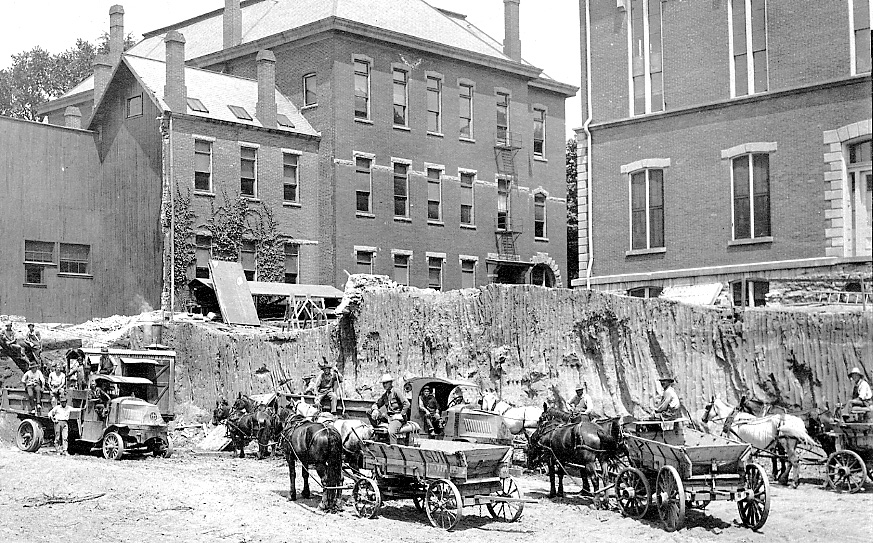
Horse-drawn
wagons pose for a 1922 image during excavation for Jessup Hall on the
University of Iowa’s
Pentacrest Campus. Background buildings are 1866 North Hall at right and 1895
Dental Building.
The image is courtesy of retired Iowa City firefighter Bob Edwards.
|
By
Bob Hibbs
An
image of horse-drawn wagons posed in what became the basement of Jessup Hall
is a vivid reminder that every edifice on the University of Iowa’s 14-acre
Pentacrest Campus was built by human and animal muscle, not by modern
hydraulic equipment.
Eleven
buildings have been erected on Pentacrest, not counting outhouses, firewood
sheds or storage cribs. Another structure, an observatory, was moved onto
Pentacrest for the 1909-1916 period.
Old
Capitol was erected at the heart of the Pentacrest during the 1840s, its dome
finally put in place the first time in 1850, then rebuilt after a 2001 fire.
The other four surviving Pentacrest denizens were completed early in the 20th
century.
All,
of course, have been extensively updated. In fact, nothing about Old Capitol
is original except its perimeter walls. It’s even air conditioned, with an
elevator and computer hookups.
Oldest
of the four academic halls surrounding Old Cap is 1902 Schaeffer. It was
extensively renovated in 1998, but despite modernization, Schaeffer retains
its century-old character.
Macbride
Hall was completed in 1908; MacLean Hall in 1912. Both also have seen updates.
The
final large Pentacrest hall to be built was the one northwest of Old Cap,
originally called University Hall and now named for the president during its
construction, the university’s 11th chief executive, Walter Jessup. He
served 18 years ending in 1934, second only to Virgil Hancher’s 24 years as
the longest presidential tenure.
The
horse-and-wagon construction image comes courtesy of retired Iowa City fireman
Robert Edwards, who inherited it from his parents. Edwards, who retired in
1987 after nearly 30 years as a fire-fighter, reports that his late father
worked in the UI plumbing shop.
Although
his father is perhaps a workmen in the image, Edwards believes the men
probably are contract employees, rather than university regulars as was his
father. However, a wagon sideboard at the center of the image carries “SUI
No. 4” labeling.
Source
of the image is unknown; but, it may be the work of the late 50-year UI
photographer Fred Kent.
Behind
the excavation, the image displays a corner of North Hall as right. The
background structure is the 1895 Dental Building with the southerly of its two
west wings still attached.
The
wings housed dental clinics until 1917 when a new dental building now called
Trowbridge Hall was opened. The west wings were demolished to make way for
Jessup, but the main section of “Old Dent” survived until 1975.
First
occupied in 1924, Jessup Hall since 1970 has in addition to academic
classrooms housed the President’s Office, which was moved as Old Capitol was
closed for conversion into a museum. All previous presidents had been housed
in Old Cap since UI began continuous operation in 1860.
Jessup
Hall also is site of the 1991 murder of vice president Anne Cleary by
disgruntled physics student Gang Lu, who also killed four others during his
campus rampage, including himself.
The
four current “halls” on Pentacrest are replacements for six earlier brick
structures, three of which burned without being rebuilt. A fourth – 1866
North Hall – also burned, but was rebuilt. Collectively, they’re called
“the red brick campus” and during their era housed nearly all university
activity.
The
North Hall fire in 1897 not only destroyed a substantial portion of the UI
library, but claiming the life of Iowa City firefighter Kirk Leek, the first
of only two local firemen killed in the line of duty during the community’s
165-year history. The other was Robert Hein who died in 1971 of injuries from
a 1969 Mercy Hospital explosion.
Although
the UI campus now sprawls over 1,900 acres, the four square blocks of
Pentacrest has a heterogeneous history, indeed.
Next
Saturday:
Stories of Iowa City’s Congregational Church. Bob Hibbs collects local postcards and other historic ephemera and researches history related to them.
|